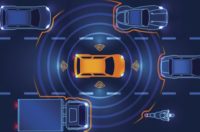The 1920s was a golden age for the automobile in America. Millions of people jumped behind the wheel for the first time and transformed mobility, not to mention just about every facet of life. History may repeat itself during the 2020s. But, this time around, cars will be driving themselves.
Autonomous vehicles are expected to be a common sight on highways by the end of this decade. Some of the research being done to make that dream a reality is currently taking place at Florida Polytechnic University, which is home to the Advanced Mobility Institute (AMI).
AMI engineers are focusing on the development, verification and testing of autonomous vehicle (AV) technology. Their R&D efforts are examining key issues such as early detection of troublesome scenarios, stress test sensors, object recognition, electromagnetic interference, safety, security and human-machine interaction.
“AV technology has the potential to have an impact as significant as the internal combustion engine,” claims Rahul Razdan, Ph.D., senior director for special projects at Florida Poly. “However, to reach its potential, a quantum leap is necessary in the verification of these technologies. Without this work, the full capabilities of AV technology will not be realized.”
To address that issue, the university recently unveiled a new simulation facility for real-time testing. The hardware-in-the-loop (HiL) room enables AMI engineers to simulate conditions such as how autonomous vehicles operate independent of weather or electromagnetic interferences, while surrounded by nonverbal human communication such as gestures and signals.
“So far, we’ve been working on and generating different scenarios as models for software-in-the-loop testing, but only doing it with software is not as realistic,” says Arman Sargolzaei, Ph.D., an assistant professor of electrical engineering who is spearheading the R&D project. “The new HiL facility will allow us to do testing that is closer to real-world scenarios.
“[This] is a great step forward to achieving cost-efficient and safe test procedures before migrating to road or test track experimentations,” Sargolzaei points out.
“Advancing HiL application domain to the era of connected and autonomous vehicles will lead to a set of exemplary breakthroughs in the field of transportation research,” claims Sargolzaei. “[This facility will] accelerate our research mission, which is to make automated vehicles safer and more secure.”
When it’s fully operational in a few months, the facility will house multiple PCs and computer servers. A team of six faculty members will work with students on research projects.
They’ll interact with a new AV proving ground that’s located just two miles away. SunTrax is a 400-acre state-of-the-art testing facility that was built in partnership with the Florida Department of Transportation, It features a 2.25-mile oval track designed for high-speed and multiple lanes of travel. A 200-acre infield area includes a simulated downtown urban area to test transit, pedestrian and bicycle interactions with autonomous vehicles.
“The goal of HiL is to make testing scenarios much closer to real-world road conditions,” says Sargolzaei. “We can use a wide variety of scenarios, such as different types of roads and weather patterns. For instance, we will be examining how rain, snow and other environmental conditions affect lidar, radar and vision sensors that autonomous vehicles depend on.
“Another issue that we plan to focus on involves cyberattacks and cybersecurity, such as how different false-failures can affect control decisions and safety issues,” explains Sargolzaei. “We hope to improve the control and perception algorithms that enable vehicles to work under those conditions.”
“We eventually plan to develop a systematic testing procedure that will be provided to automakers and suppliers, in addition to state and federal regulators,” adds Sargolzaei. “It will apply to any type of unmanned vehicle that rolls, floats or flies.”




